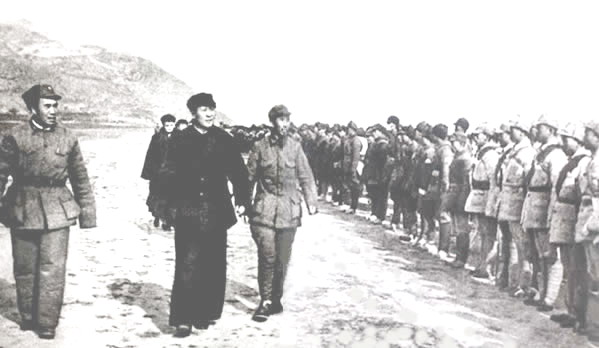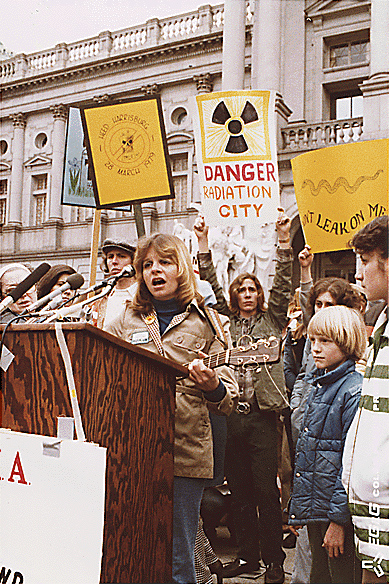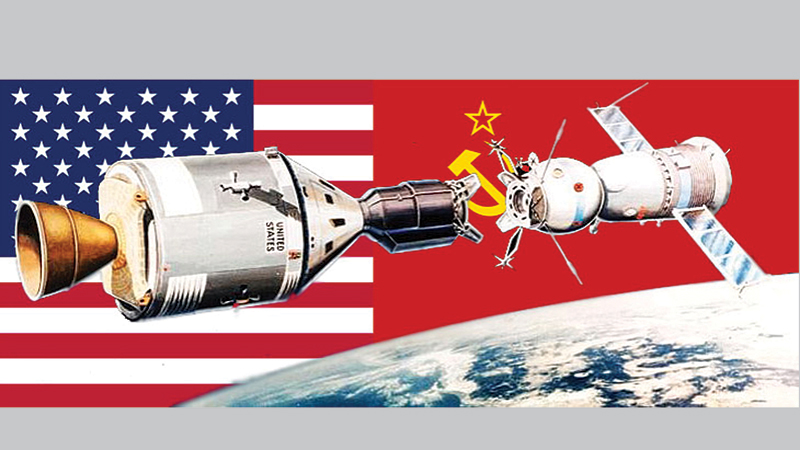Focus Question: Where were Cold War conflicts between the United States and the Soviet Union?

Topics on the Page
The Korean War
- The Truman Doctrine
Germany
- Dramatic Event page: Berlin Airlift and the Berlin Wall
- Prague Spring, the Brezhnev Doctrine and the Soviet Invasion of Czechoslovakia
China
The Middle East
The arms race
The Space Race
- Dramatic Event page: Sputnik and the Space Race
Latin America
Africa
The Vietnam War
 Cross- Link: AP US History Key Concept 8.1: The US and the Cold War
Cross- Link: AP US History Key Concept 8.1: The US and the Cold War
Cross-Link: The Cold War Between the US and the USSR
![]() Interactive Map of Cold War Europe
Interactive Map of Cold War Europe
See also The Berlin Crisis (1948-1949) from the site, The Map in History.
This documentary, On the Brink: Doomsday, from the Discovery Channel, goes over the areas of conflict, and their causes over the course of the Cold War as the U.S. and USSR fought over global superiority and control.
For a complete overview of how the United States went from allies to enemies with the Russia/USSR, check out this exhibit called "Revelations from the Russian Archive," complete with primary documents from the Soviet Union, all provided by the Library of Congress.![]() Click here for lesson plans and resources on the Cold War
Click here for lesson plans and resources on the Cold War
The growing concern of Communism’s expansion led to the policy of Containment, the strategy of the United States to stop the “domino effect” of nations moving in favor of the Soviet-Union idea of communism because of poor economic conditions.
Women's Rights and the Cold War - an article published by Harvard University press on how the conflict of the Cold War propelled women's movements of the era
Lesson plan from Khan Academy about women in the 1950s
Syngman Rhee, President of Korea and Rear Admiral Ralph A. Ofstie, May 1952

The Korean War 1950-1953
A Concise History of the Korean War
Began with the invasion of capitalist South Korea through forces in Communist North Korea.
- The United States and the Soviet Union agreed to control the country temporarily (as requested by the Koreans). The U.S. and the USSR approved the proposed Korean-led governments: the North favored communism (USSR supported) and the South feared communism (supported by the United States). The country was divided along the 38th parallel.
- The government that emerged was led by Syngman Rhee. South Korea’s left-wing parties boycotted the elections because they didn’t like the U.S. support of the suppression of indigenous political movements.
 In response, the Soviet Union approved the rise of Communism in the North. Kim Il-Sung became leader of the new Korean government.
In response, the Soviet Union approved the rise of Communism in the North. Kim Il-Sung became leader of the new Korean government.
- Both U.S. and the Soviet Union seemed to be more concerned with being in control at the beginning of the Cold War than they were with helping unify Korea under an elected government.
- Both Soviet and American forces withdrew.
- The Korean War is one of the few military conflicts of the Cold War.
Click here for a timeline of the Korean War
Click here for a lesson plan on the Korean War![]() During the Korean War, United Nations forces made up largely of troops from the United States and South Korea fought against troops from North Korea and:
During the Korean War, United Nations forces made up largely of troops from the United States and South Korea fought against troops from North Korea and:
A. the Soviet Union
B. Japan
C. China
D. Vietnam
Correct Answer: C (Question taken from the 2010 National Assessment of Educational Progress)
- The aim of the Truman Doctrine touched on two areas, supporting European governments with an aide after World War II and the containment of communism.
- Tried to get Congress to commit four hundred million dollars in military aid to Greek and Turkish governments while another twelve billion from the Marshall Plan went to go support Western Europe.
- The other part of the doctrine global containment of communism which becomes the basis for the Cold War for the next thirty-five years.
- The point of containment was to prevent the spread of communism not just in the Western Hemisphere but around the world
A good place to look at Truman Doctrine click here
Germany
 |
| Map showing sectors of occupation of Berlin |
The Truman administration came to the conclusion that the economic failures of Europe could not be repaired until the German industrial base was restored. Stalin built a blockade to block the western access to West Berlin (to hold off US influence).
- Truman maintained supplies to the areas past the blockade by flying supplies there. (This is known as the Berlin Blockade).
Dramatic Event page on the Berlin Airlift and the Berlin Wall
- The US established West Germany from the other three Western Zones of occupation.
- The Soviet Union retaliated by proclaiming its zone of occupation as the German Democratic Republic (which became one of the focal points of tensions in the Cold War).
Click here for resources on Germany and its divisions
Prague Spring, the Brezhnev Doctrine and the 1968 Invasion of Czechoslovakia
In August 1968, the Soviets invaded Prague to crack down on efforts to reform Communism in Czechoslovakia.
Reformers wanted to soften the regime, make it a little more humanizing. At the time, Czechoslovakia's economy was suffering, and in order to face the challenges that this posed, they wanted to ease the Communist restrictions and policies in an attempt to allow the economy to heal.
The USSR responded by sending Warsaw Pact troops, recalling Hungary's rebellion in 1957.
- The USSR managed to put a stop to the reforms, but also to send a message to other satellites of the USSR: "We still own you". A more conservative, pro-Soviet leader was installed, and the economy got better as a direct result of the interference, but the invasion had some heavy consequences.
- Lyndon B. Johnson, and the current Soviet leader, Leonid Brezhnev, were to discuss the easing of relations and of the arms race, but Johnson canceled the meeting because of the invasion of Prague.
- The decision to invade Prague was justified using what would be called the Brezhnev Doctrine, that Moscow had the right to intervene wherever a communist government was threatened. This assertion would lead to the final split between Sino-Soviet relations, with Mao worried that the Soviets would interfere with Chinese Communism. It was also this reasoning that led to the invasion of Afghanistan in 1979.
- On the other hand, this was interpreted in the U.S. by some as an example of how the USSR was not interested in expanding their control, only solidifying, and called for a reduction in U.S. military forces in Europe.
For more information see this article from the U.S. Office of the Historian.
Newsreel Footage of the Soviet Invasion
This Opinion article from the New York Times in 1968 looks at how the Brezhnev and Gorbachev foreign policies, or Doctrines, were not all that different, even though Gorbachev claimed to be a new, friendlier face of the USSR.
China
In 1949 Mao’s Red Army defeated the Kuomintang regime in China (this regime had been supported by the US).
- The Soviet Union became allies with the new People’s Republic of China.

Mao inspecting China's Red Army
In response to this alliance, Truman wanted to expand the policy of containment quickly.
![]()
- Truman created a secret document called the NSC-68 that outlined the national security strategies of the United States. It also considered military, economic, political, and psychological capabilities of the Soviet Union and the United States.
- Mao created a Five Year Plan to make China one of the world's top powers
Click here to read about China from 1949 to 1953
Insightful book to read about Mao and the Red Army is Red Star Over China
The Middle East
President Harry Truman's "Immigration into Palestine" Speech, October 4, 1946.
In the 1950’s the U.S. was the guarantor of stability for the Middle East, often using government agencies such as the CIA to replace communist governments with more US friends governments. Republic revolutions brought western regimes to power in Egypt, Syria, and Iraq. The Soviet Union wanted to spread its influence and made allies with Arab rulers including Saddam Hussein (Iraq). These regimes gained support in exchange for the promise to destroy Israel and the United States. There was also hope for Arab prosperity.
Click here for a detailed background on the US and Egypt in the 1950s
Click here for a timeline of the Middle East from 1950-1979
This article from the U.S. Office of the Historian discusses how the conflict between India and Pakistan in 1965 was brought into the Cold War conflict, creating another area of contention between the U.S. and the USSR.
Arms Race
The competition of supremacy for nuclear weapons between the United States and the Soviet Union. After WWII (when the United States dropped for the atomic bomb), The Soviet Union began building its own nuclear weapons. When the Soviet Union detonated their atomic bomb, the United States made increasing efforts to exceed it. The competition for nuclear weapon supremacy had begun.
Anti-Atomic Bomb Protest

- The United States created the hydrogen bomb and detonated it on November 1, 1952. The Soviet Union detonated their own version of the Hydrogen Bomb the following August.
- The Soviet Union launched Sputnik, whose launch vehicle was designed to carry nuclear warheads. These satellites showed it could release nuclear weapons to anywhere in the world.
- Soviet Union’s Khrushchev formed an alliance with Cuban leader Fidel Castro. U.S. President John F. Kennedy responded to the installation of nuclear missiles in Cuba with a naval blockade.
- This blockade almost brought a nuclear war to its breaking point. This became known as the Cuban Missile Crisis.
- The Cuban Missile Crisis demonstrated that neither nuclear superpower was ready to use their nuclear weapons because each feared the other retaliation (both would be destroyed).
- Click here to read about "Mutually Assured Destruction"
Concerns about nuclear war and the destruction of humanity were common themes in popular culture during the Cold War. Click here for the Wikipedia page on nuclear weapons in popular culture.
Europe- The Final Countdown
The Nation. magazine's Top Ten Songs about Nuclear War
The World on the Brink: John F. Kennedy and the Cuban Missile Crisis/Thirteen Days in October 1962from the JFK Presidential Library.
Click here for a lesson plan from the National Archives on nuclear testing and nuclear fallout

The Space Race
Link to Space Race, an online exhibit from the Smithsonian.
Link to Dramatic Event page Sputnik and the Space Race
The space race began in the late 1950's and it pitted the U.S. and Soviet Union against each other once again.
- This time the conflict was over which country could produce more advanced technology.
- Producing more advanced technology could help promote country wide superiority which would thus make either the U.S. or Soviet Union political system better in comparison.
- A greater ability to control the sky and space would allow for greater military superiority as well.
- This is why it was such a big deal for each country to claim superiority over space.
- On October 4th 1967 the soviets launched sputnik which was the first satellite and man made object thrust into earths orbit.
- In response the U.S. launched explorer 1, their own satellite in 1958. This was shortly followed by the creation of NASA.
- The soviets then launched Luna 2, the first probe to reach the moon soon followed by the launch of Vostok 1 which took Yuri Gagarin to space as the first man to orbit earth.
- The U.S. responded again by sending their own design named project mercury into space. The first missions had chimpanzees aboard yet later down the line the U.S. successfully got their first man into space, Alan Shepard.
- After the U.S. launched its mercury protect JFK famously announced that the U.S. would land a man on the moon before the end of the 60's.
- The U.S. then expanded their NASA funding and created the Apollo program.
- Apollo 8 was the first mission to orbit the moon (1968) and at the end of the decade (1969) the first manned mission to land on the moon, Apollo 11, was successful.
- The soviets attempts to reach the moon were stalled by internal debates of its importance as well as the death of their leading scientist.
- By being the first to land men on the moon the U.S. were deemed the victors of "the Space Race"
Latin America
Before Cold War, the Latin American governments ruled through an alliance with the United States. By the mid-20th century, the region made economic developments which pushed for social change and political independence; challenging the U.S. influence.
- Marxists gained influence in the regions in the 1960’s, giving fear that Latin American instability would threaten national security.
- During the Cold War, the US was a barrier to socialist revolutions. The CIA would overthrow governments that were suspected of turning communist (like Guatemala in 1954).
Click here or here for a history of Latin America and the US during the Cold War
Africa
 |
| Patrice Lumumba, 1961 Soviet stamp |
- After mass decolonization, a result of the end of WWII, the United States and the Soviet Union found themselves competing for areas of influence in Africa.
- The Democratic Republic of the Congo requested Soviet aid.
- Before, many United Nations peacekeepers were in the Congo. The United States had used the area to shut down air traffic and prevent the Soviet arms to influence the region.
- The area alienated itself from both United States and the Soviets (considered to be weak, and unethical)
Click here for information on Africa and the Cold War from the BBC
Good documentary on African and the Cold War click here
The Vietnam Wars 1955-1975

- The Geneva Accords, which divided the country along the 17th parallel, promised reunification in 1956 with democratic elections that would determine the leadership of the entire country.
- The United States intervened knowing that the elections would lead to a Northern Communist victory and began providing aid to South Vietnam in the hopes that the South would remain a Democratic nation.
- The Vietnam War soon broke out between the Communist North, led by Ho Chi Minh and backed by the Soviets and the South, led by Ngo Dinh Diem and backed by the United States.
- One of the few military conflicts of the Cold War, the Vietnam War ended in 1975 with a Communist victory after the United States had withdrawn its troops and support from the South in 1973.
 Timeline of the Cold War
Timeline of the Cold War
The maximum extent of Soviet influence in 1960.
Click here for a brief history of the people living in Vietnam during this time period.
Works Cited
[1] (2007). Korean War. In Wikipedia [Web]. Retrieved April 25, 2007, from http://en.wikipedia.org/wiki/Korean_War.
[2] (2007). Latin America. In Wikipedia [Web]. Retrieved April 25, 2007, from http://en.wikipedia.org/wiki/Cold_War_%281953-1962%29#Latin_America.
[3] (2007). Soviet Union. In Wikipedia [Web]. Retrieved April 25, 2007, from http://en.wikipedia.org/wiki/Vietnam_War#Soviet_Union.
[4] (2007). Containment. In Wikipedia [Web]. Retrieved April 25, 2007, from http://en.wikipedia.org/wiki/Cold_War_%281962-1991%29#From_.22Containment.22_through_the_Korean_War_.281947-1953.29.
[5] (2007). History of the Middle East. In Wikipedia [Web]. Retrieved April 25, 2007, from http://en.wikipedia.org/ wiki/History_of_the_Middle_East#European_domination.